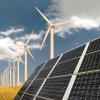
Impact Sheet #8, November 2014. The Global Energy Assessment (GEA), coordinated by IIASA, provides the scientific basis for the 2012 global initiative, Sustainable Energy for All (SEforALL), launched by former UN Secretary-General Ban Ki-moon. In addition, IIASA/GEA scientists developed analytical tools and policy options for the Global Environment Facility (GEF), the largest public funder of projects to improve the global environment. GEA authors, many from IIASA, also provided substantive input to the 2014 Intergovernmental Panel on Climate Change (IPCC) Fifth Assessment Report.
The GEA is the first ever fully integrated energy assessment to analyze energy challenges, opportunities, and strategies, for the world’s economies. Conducted by 500 of the world’s leading energy experts in research, academia, business, industry, and policy from the developing and developed world, the GEA is supported by government and nongovernmental organizations, the UN system, and the private sector. The GEA clusters around four topics that are key to the current, much-needed energy transformation: review of major 21st century energy challenges; assessment of current energy technologies; options and pathways to solutions; and policy recommendations and tools to achieve goals. The scientific assessment, writing, and peer review took five years and results were published in a 1882-page book in 2012.
GEA – SEforALL, GEF, IPCC
The GEA database includes detailed quantitative information for 41 pathways to sustainability. Six GEA scenarios meet the three SEforALL objectives: i) providing universal access to modern energy services, ii) doubling the global rate of improvement in energy efficiency, and iii) doubling the share of renewable energy in the global energy mix. These six scenarios underpin all SEforALL scientific work. As Kandeh Yumkella, founder of SEforALL, says: “The IIASA Global Energy Assessment served as both the scientific basis for SEforALL, and the inspiration behind our aims.”
Work for the GEF has centered on the development of GEA scenarios, coordinated by IIASA researcher Keywan Riahi. Moreover, 42 GEA authors contributed to IPCC Fifth Assessment Report, published in 2014.
Impacts
- The SEforALL Initiative of the UN Secretary-General was created based on the analysis and contribution of the GEA and led to a design based on three targets for energy access, energy efficiency, and renewable energy.
- These three targets later became the blueprint for the UN Sustainable Development Goal seven on affordable and clean energy.
- The GEA contributed to the scientific foundations for the SEforALL Global Tracking Framework report, led by the World Bank Group and the International Energy Agency, which monitors progress towards the three SEforALL objectives.
- IIASA researchers helped shape the strategy and work of the UN Secretary- General in the area of climate via the high level advisory group on energy and climate change.
- User-friendly policy tools for decision makers based on GEA analysis are now freely available on the internet. The Energy Access Interactive Tool helps policymakers improve energy access for the rural poor in developing countries. The Energy Multi-Criteria Analysis tool is designed to help decision makers interactively analyze, compare, and tackle energy’s social, economic, and sectoral impacts in an integrated way. Databases documenting the results and assumptions used in the GEA transformation pathways are also available online.
- The GEA was referenced in 13 chapters of the Working Group III Report (Mitigation of Climate Change) of the IPCC Report, which was a vital part of the Paris Agreement.
